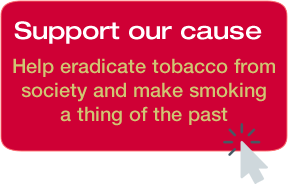Case against the tobacco industry: an overview
17 November 2017

Over one year ago, lawyer Bénédicte Ficq filed a criminal complaint against the tobacco industry on behalf of two lung patients and the Youth Smoking Prevention Foundation. This article provides an overview of the lead-up to the case and subsequent developments.
By Bas van Lier
‘I cannot conduct this alone and, to be honest, I don’t know if I’ll be around next year. But I’m doing it for my children and hope that everybody will help me.’ Those were the words of Anne Marie van Veen, at the time a 43-year-old mother of 4 children and a lung cancer patient, when he appeared in the RTL Late Night television programme on 28 April 2016. Together with criminal lawyer Bénédicte Ficq, she was there to announce that she was instigating criminal proceedings against the tobacco industry for attempted murder, manslaughter and grievous bodily harm.
One year earlier, on World No Smoking Day, Van Veen attended the premiere of the documentary ‘De Vervangers’ (‘The Replacements’). In this documentary Erwin Kleinjan exposed the tactics employed by the tobacco industry to ensure that tobacco continues to appeal to children. For in order to maintain its business model, the industry needs those children to replace the 20,000 smokers who die each year in the Netherlands as a result of their addiction.
In part owing to the influence of the documentary, made on behalf of the Youth Smoking Prevention Foundation, Van Veen concluded that she wanted to protect her children against the malicious practices of the tobacco industry. She also realized that she could not do it on her own. During a meeting some months later with lung doctor Wanda de Kanter, chairwoman of the Youth Smoking Prevention Foundation, the doctor proposed putting her in touch with criminal lawyer Bénédicte Ficq, a member of the foundation’s Committee of Recommendation, in order to mount a legal challenge against the tobacco industry.
Sick of Smoking
Under the leadership of De Kanter, the Youth Smoking Prevention Foundation launched a process that culminated in the criminal case presented to the Dutch Public Prosecutor on 29 September 2016. Criminal lawyer Bénédicte Ficq was approached, and after a preliminary study indicated that there were sufficient grounds to take on the case, she embarked on months of preparatory research.
To generate as much public support as possible, a grassroots movement called Sick of Smoking was formed. Right from its launch, on 28 April 2016, the website sickofsmoking.nl became the focus of the campaign. The website is used to publish information about the case against the tobacco industry and gathers expressions of support. A voting button allows people to back the campaign, and within days of the launch the number of people who had done so reached almost 12.000. Today, more than 24.000 people did express their support.
People can also support the case with their name, photograph and a personal motivation, and some 2,000 people had done so by early May and several thousands until now. Among them was Charlotte Köll, who expressed her motivation sharply: ‘Drug dealers and murderers end up in jail. So why is the tobacco industry protected and not ordinary people?!’ And Wil de Jong wrote: ‘A soft approach to the tobacco industry achieves little. It’s time for “serious” action.’
The website also called on sick smokers to get behind the case, a call that has been answered by some 2,000 people already.
Wave of publicity
The launch of Sick of Smoking and the announcement of the case triggered a wave of publicity. That comes as no surprise, because this is the first time anywhere in the world that a criminal case has been brought against the tobacco industry. There have been many civil cases in which ill smokers or their descendants claimed compensation, usually resulting in a ruling against the tobacco industry. But never before have cigarette manufacturers been criminally prosecuted for systematically violating the law.
However, lawyer Bénédicte Ficq believes there is every reason to do that, as she explained at the launch of the case: ‘If a person feeds his children a spoonful of rat poison every day, that person will obviously be charged with murder. The tobacco industry does exactly the same. It supplies poisonous sticks made in such a way that people can easily ingest the poison. Moreover, the design of the cigarette makes clear that the industry deliberately and premeditatedly aims to harm the health of people.’
Additives
Ficq has received support for her initiative from many quarters. ‘I had my doubts about the case at first,’ commented emeritus professor of intellectual history Frank Ankersmit in the newspaper Trouw. ‘A smoker should in principle know what the risks are and is responsible for his own behaviour. Yet there is an interesting aspect to the case: the substances added to cigarettes. Tobacco producers add all sorts of substances that make cigarettes addictive. They do that deliberately, since these are additives, substances that do not occur naturally in tobacco. That is an essential difference with alcoholic drinks for example. They can also be addictive. Yet you could hardly accuse a winegrower or beer brewer of adding alcohol to their product. After all, everybody knows that beer and wine are alcoholic drinks.’
Insider Wigand
The charge against the tobacco industry received a boost when the American chemist and whistle-blower Jeffrey Wigand (The Insider) came to the Netherlands. Wigand, a former employee in the tobacco industry but a staunch opponent of it since 1994, revealed the practices used in the industry.
According to Wigand, tobacco manufacturers employ scientists to study the behaviour of children so that they can get them to smoke, he told the current affairs TV programme EenVandaag. The industry does all it can to make cigarettes as tasty and addictive as possible. Wigand: ‘Today’s modern cigarette is a sophisticated way of controlling the delivery of the drug nicotine. In order to make that nicotine tasty, they throw in more than 620 additives. Some of these additives make nicotine tasty, make it easier to smoke, defeat the cough reflex, make it go down more smoothly.’
‘Rigged’ cigarette
Wigand also revealed to Ficq and her team how the cigarette companies make tiny holes in the filters of cigarettes in order to sabotage the official measurements of harmful substances. The holes in the filters, almost invisible to the naked eye, draw extra air into the measurement machines. As a result, those machines measure lower values than those actually inhaled by smokers. As Wigand demonstrates, smokers block the holes with their lips and fingers as they smoke. Because of this, smokers inhale 2 to 3 times the recorded levels of harmful substances.
If the machines used by testing bodies such as the National Institute for Public Health (RIVM) measure values that remain just below the maximum allowable emission levels for tar, nicotine and carbon monoxide (TNCO), then smokers inhale 2 to 3 times that maximum amount. That makes the cigarette in its current form an illegal product, concludes Ficq. To be clear: all filter cigarettes are fitted with such ventilation holes. Therefore all filter cigarettes are ‘rigged cigarettes’.
It is not surprising that this deception with holes has generated a particularly high level of publicity in relation to the case, which was finally filed on 29 September 2016. In it, four tobacco manufacturers that are active in the Netherlands — Philip Morris International, British American Tobacco, Japan Tobacco International and Imperial Tobacco Benelux — are accused of attempted murder and/or manslaughter and/or attempted grievous bodily harm and or attempted and premeditated harming of the health. Falsification of documents is another charge on the list.
The complaint documentation filed, which runs for 30 pages as well as annexes, argues that the tobacco industry deliberately makes cigarettes more addictive by adding hundreds of additives, which makes new smokers addicted quickly and makes existing smokers more addicted. Moreover, the industry makes those holes in the filters to fool the test machines.
Parties lend their support
The case was initially brought by Ficq on behalf of Anne Marie van Veen, the 66-year-old COPD patient Lia Breed, and the Youth Smoking Prevention Foundation. In the months that followed, more and more organizations joined. In March the Dutch Cancer Society (DCS) was the first. “The DCS is extremely shocked by the facts brought to light through the legal research by Ficq,” the organization wrote on its website. “And in particular, the finding that smokers have for years been consistently and deliberately misled by the tobacco industry. That’s why the DCS is also filing a criminal complaint and supporting the legal challenge.”
The Dutch Journal of Medicine (NTvG) and the Claudicationet, which represent doctors and physiotherapists respectively, followed that example in May.
Political support
Politicians have also become involved in the case. On 10 October the Socialist Party raised questions in parliament concerning the rigged cigarette and what the government did with information released by the RIVM as far back as 2012. State Secretary Van Rijn (Health, Welfare and Sport) responded over a month later with the statement in which he expressed his ‘alarm’ at the misleading information about the poisonous nature of cigarettes and he notified the Netherlands Food and Consumer Product Safety Authority (NVWA) of a possible infringement of the national Tobacco Act.
In May 2017 an article appeared in the authoritative Journal of the National Cancer Institute with the results of a study carried out by Ohio State University for the National Cancer Institute in the United State. This indicates that smokers have a higher chance of getting lung cancer because the holes in the filters mean that they ingest more chemicals.
Some months later, in August 2017, the RIVM caused a stir with an article on its website that outlined the accusation that the holes in cigarette filters generate an inaccurate picture of the TNCO levels inhaled by smokers. The RIVM explained that its decision to comment publically was prompted by the number of questions it received concerning the rigged cigarette. “The amounts of tar, nicotine and carbon monoxide (abbreviated to ‘TNCO’) determined using the EU-prescribed standard measurement method are lower than those inhaled by a smoker,” wrote the RIVM.
Support from the State Secretary
Lawyer Bénédicte Ficq feels greatly encouraged by the position taken by the RIVM. “This is the official confirmation of our position,” she commented. And in the television programme Jinek, she added: “That means that an ordinary cigarette is not a legal product, because laws and regulations have been violated.”
By then, the outgoing State Secretary Van Rijn was also convinced, as he made clear in a letter he sent to parliament just days before leaving office. In it he declared that the government wanted to end the practice of ‘rigging’ cigarettes as quickly as possible because the holes in the filters falsify measurements of harmful substances in cigarette smoke. Van Rijn urged his colleagues in Europe to take swift action in changing the measurement methods.
Van Rijn: “I think that everybody knows well that smoking is deadly, but people should at least know what they are really inhaling. It appears that the levels currently measured greatly underestimate what people actually inhale. We must change this situation as quickly as possible.”
The RIVM is not going to wait for European legislation in this area, it stated on 28 October. Instead, the institute announced that it will soon publish a ‘shame list’ of 100 popular brands of cigarette to show just how poisonous a cigarette really is when smoked normally.
In the meantime, the Dutch Public Prosecutor has spent more than a year considering whether, on the basis of the criminal complaint submitted, to bring the case to court.
To be continued.





 Rookpreventie Jeugd is registered as a Public Benefit Organisation.
Rookpreventie Jeugd is registered as a Public Benefit Organisation.